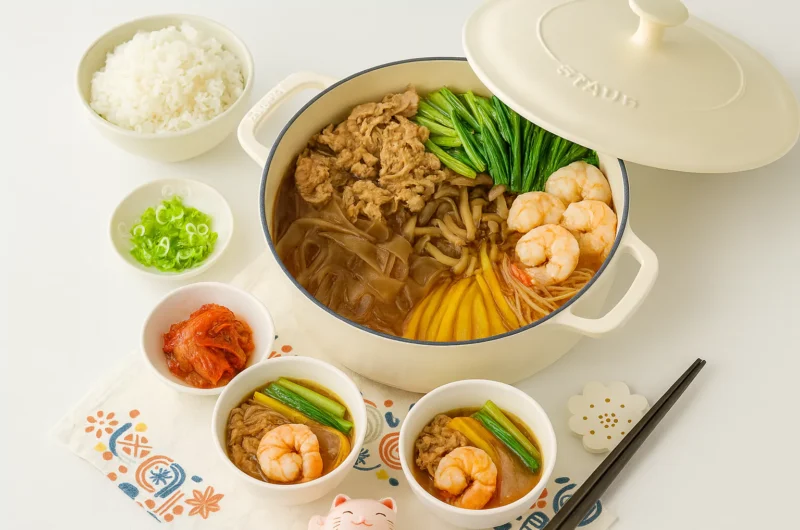Do you think noodle soups are always plain or too heavy? What if you could enjoy a bowl that’s both light and filling, spicy yet refreshing, and full of healthy vegetables? That’s exactly what Stewed glass noodles bring to your table. This dish combines chewy noodles, colorful vegetables, and a bold broth that will make you crave spoonful after spoonful.
In this guide, you’ll learn how to prepare Stewed glass noodles step by step. You’ll discover the essential ingredients, expert cooking tips, and creative variations to make this dish your own. Let’s dive into the world of Stewed glass noodles with vegetables in spicy soup and see why it deserves a place in your kitchen.
Overview
Stewed glass noodles are a warming and nutritious dish that balances flavor, texture, and health. Known in Japanese as 野菜たっぷり麻辣湯風春雨煮込み, this dish translates to “Stewed glass noodles with plenty of vegetables in spicy mala-style soup.” Inspired by Sichuan-style cooking, it carries a spicy yet well-rounded taste that excites the palate.
- Cooking time: 30–40 minutes
- Difficulty level: Easy to moderate – perfect for home cooks
- Why it’s special: Unlike many soups, this one combines protein, vegetables, and noodles in a balanced way. The broth is light yet deeply flavorful, the noodles are chewy, and the vegetables add freshness.
Stewed glass noodles stand out because they are versatile. You can prepare them with chicken, shrimp, mushrooms, and seasonal vegetables, making it adaptable for any household.
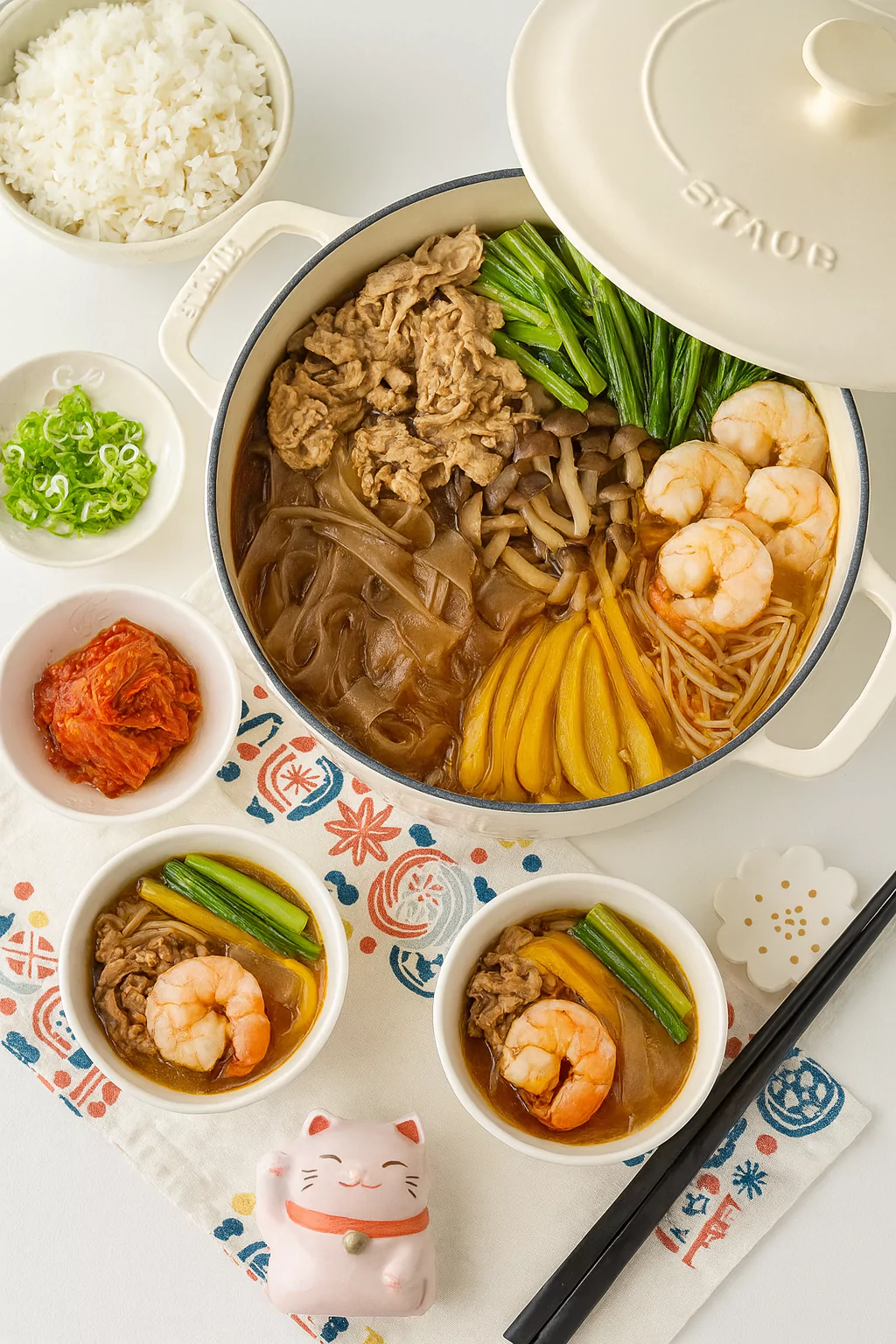
野菜たっぷり麻辣湯風春雨煮込み
Essential Ingredients
Here’s what you’ll need for Stewed glass noodles:
- Beef slices (200g thinly sliced into pieces): Juicy and tender, perfect for stew. Can substitute with chicken thighs or tofu.
- Shrimp (6–8 pieces, peeled and deveined): Adds natural sweetness to balance the spice.
- Bean sprouts (200g, 1 bag): Refreshing crunch. Substitutes: cabbage or bok choy.
- Komatsuna (½ bunch): A Japanese leafy green with a mild taste. Substitutes: spinach, kale, or Swiss chard.
- Yellow bell pepper (½ piece): Sweetness and color.
- Shimeji mushrooms (100g): Earthy flavor and soft bite. Substitutes: shiitake, enoki, or button mushrooms.
- Glass noodles (80g dried): The heart of the dish, chewy and satisfying.
For the broth:
- Water: 800ml
- Chicken stock base: 1 ½ tablespoons
- Gochujang (Korean chili paste): 1 ½ tablespoons
- Soy sauce: 1 ½ tablespoons
- Salt: ½ teaspoon (adjust to taste)
Aromatics & Flavor:
- Garlic (1 teaspoon, grated)
- Ginger (1 teaspoon, grated)
- Sesame oil (2 teaspoons)
- White pepper powder (½–1 teaspoon)
- Chili oil for finishing
Why they matter
The balance of chicken, shrimp, mushrooms, and greens makes Stewed glass noodles a dish full of flavor and nutrition. The broth builds layers of spice, aroma, and umami, making it the soul of the recipe.
Step-by-Step Instructions
Step 1: Prepare the noodles and proteins
- Soak the dried glass noodles in hot water or cook as instructed. Drain and rinse under cold water.
- Cut beef into bite-sized pieces.
- Pat dry shrimp to remove excess water.

Step 2: Prepare the vegetables
- Chop komatsuna into 4 cm lengths, separating stems from leaves.
- Thinly slice the yellow bell pepper.
- Break shimeji mushrooms into small pieces.
- Wash and drain bean sprouts.
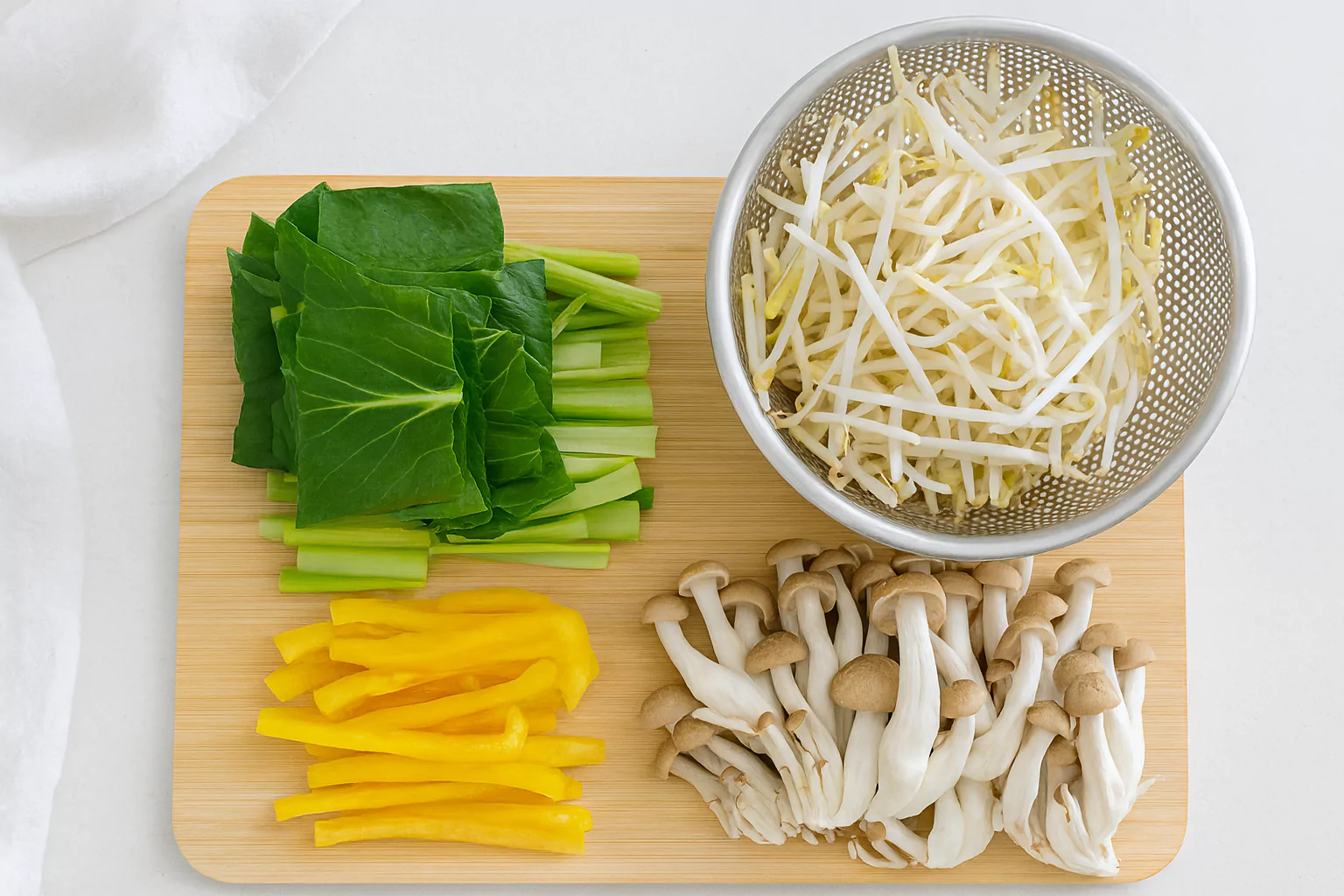
Step 3: Build the flavor base
- Heat sesame oil in a pot.
- Add garlic and ginger, stir until fragrant.
- Add beef and stir-fry until no longer pink.
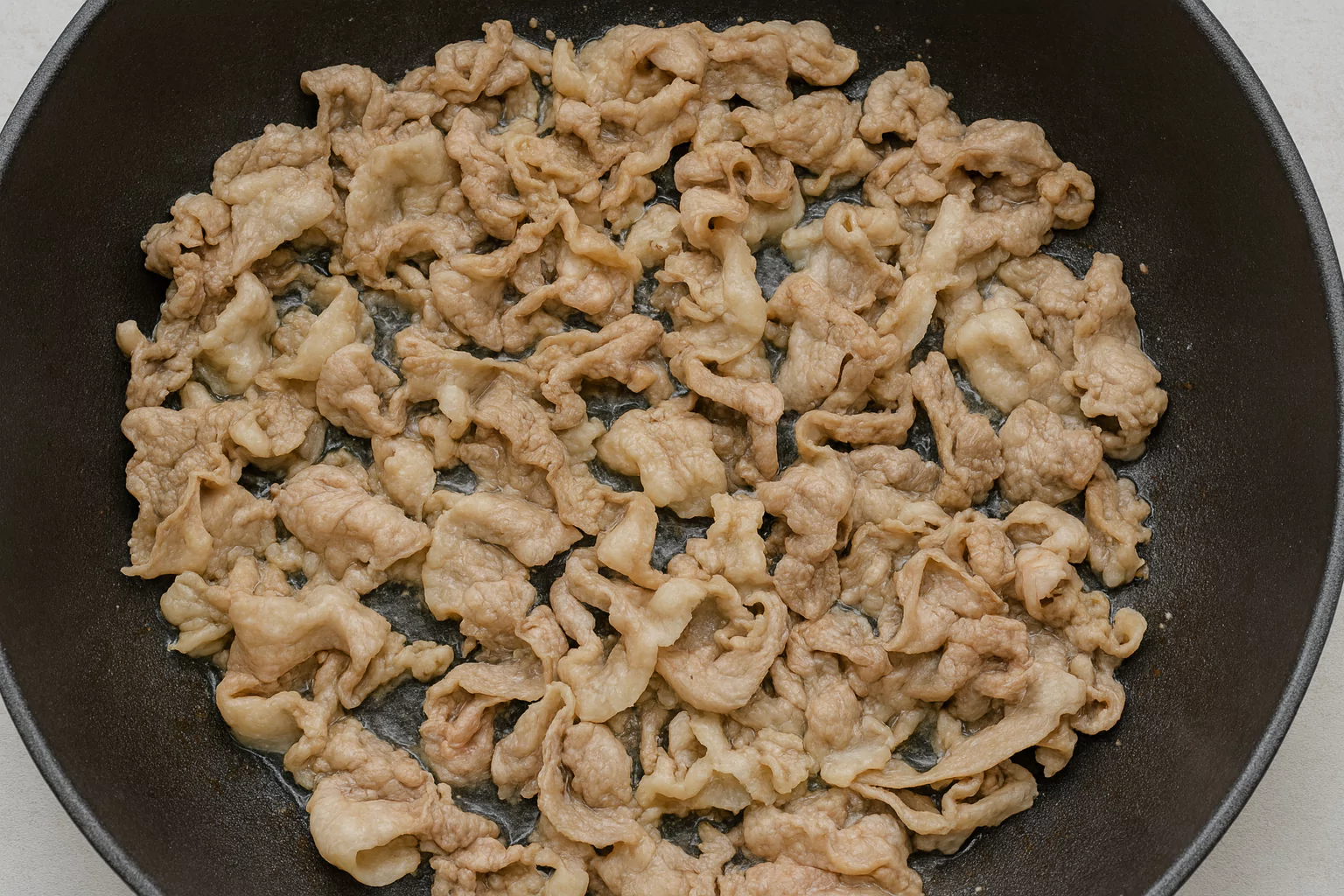
Step 4: Add shrimp and mushrooms
- Toss in shrimp and mushrooms, stir for 1–2 minutes.
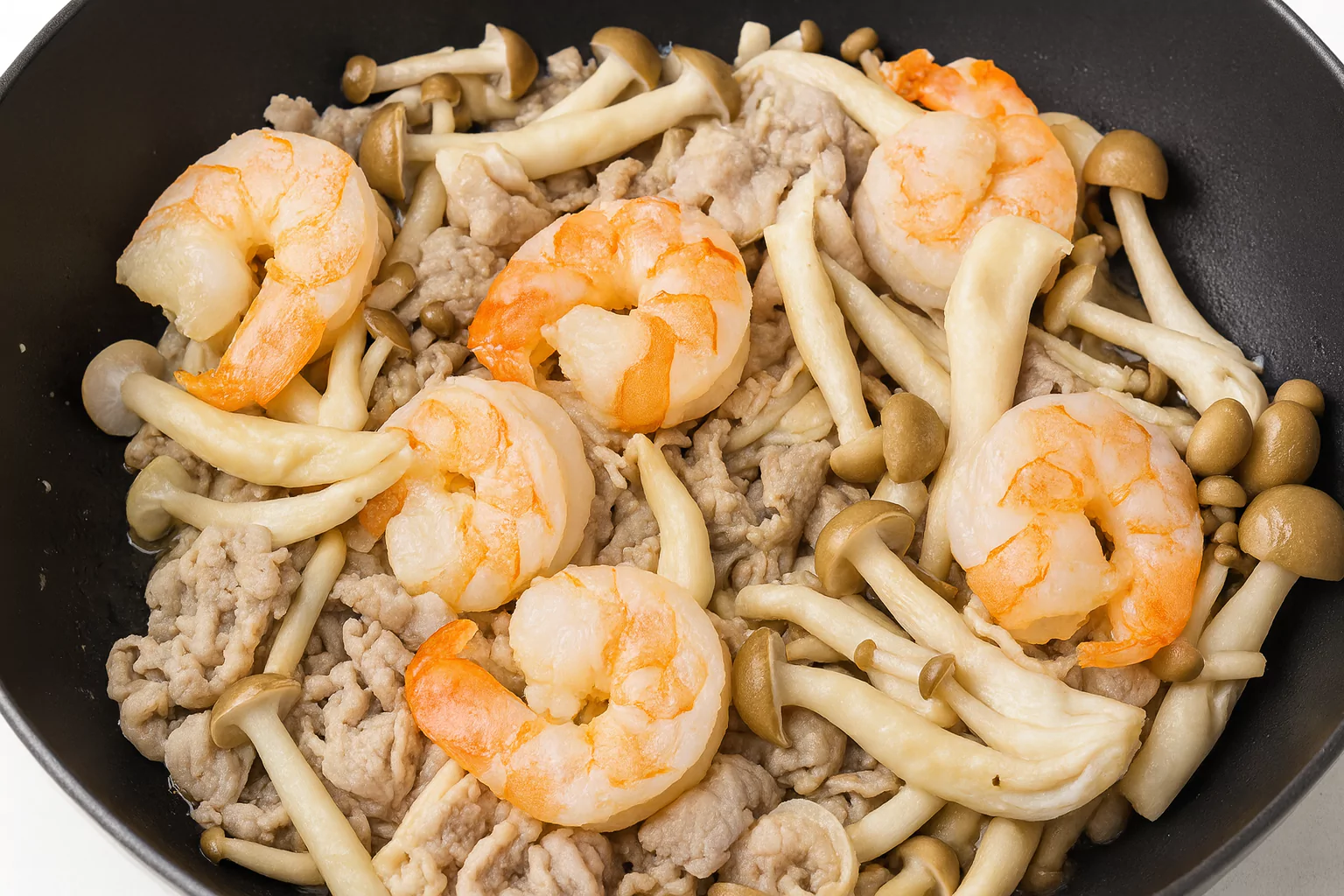
Step 5: Create the broth
- Pour in water, add chicken stock, gochujang, soy sauce, and salt. Bring to a boil.
- Add glass noodles, bean sprouts, bell pepper, and komatsuna stems. Simmer for 2–3 minutes.
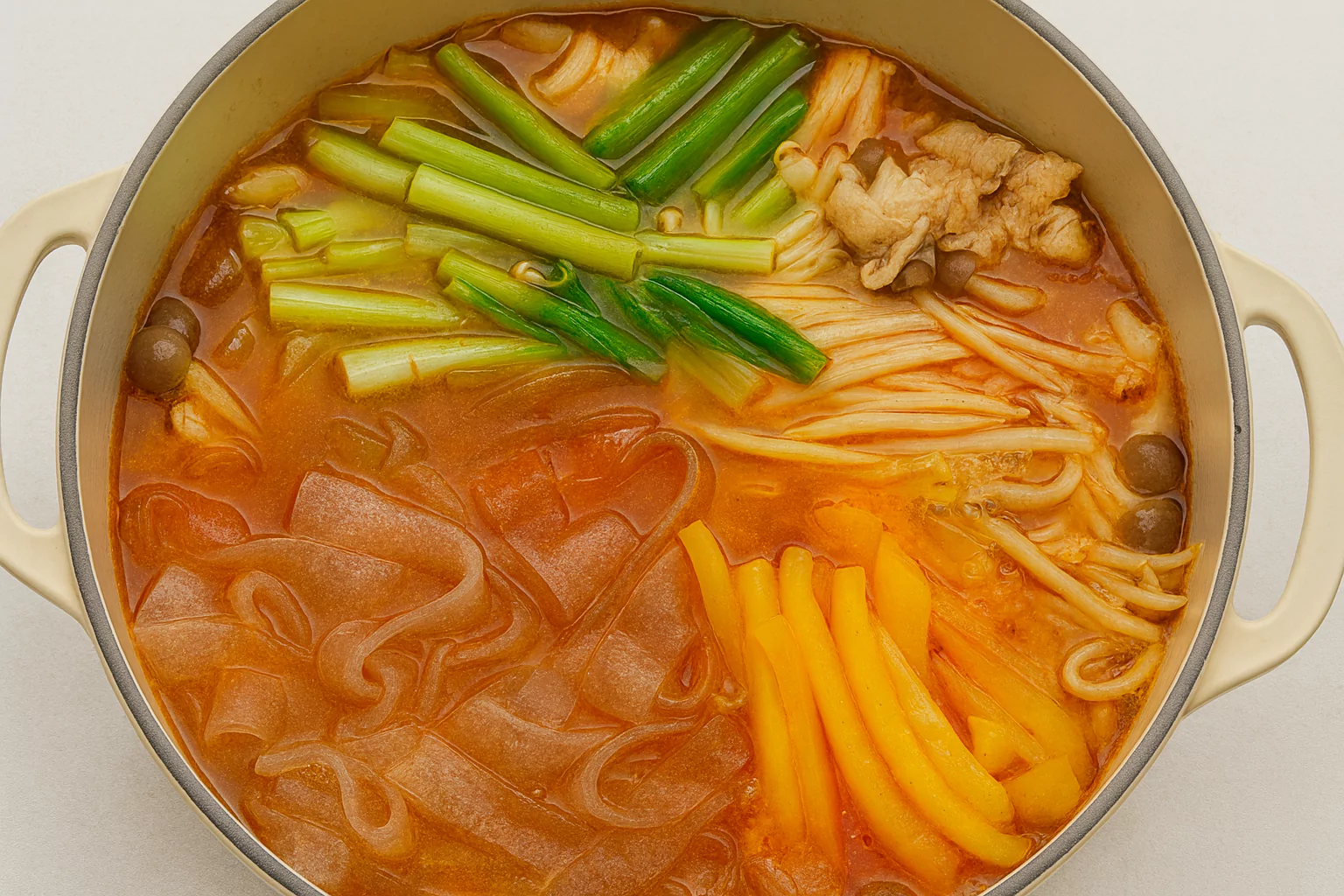
Step 6: Finish with greens
- Add komatsuna leaves and cook briefly until just wilted.
- Season with pepper and drizzle with chili oil.
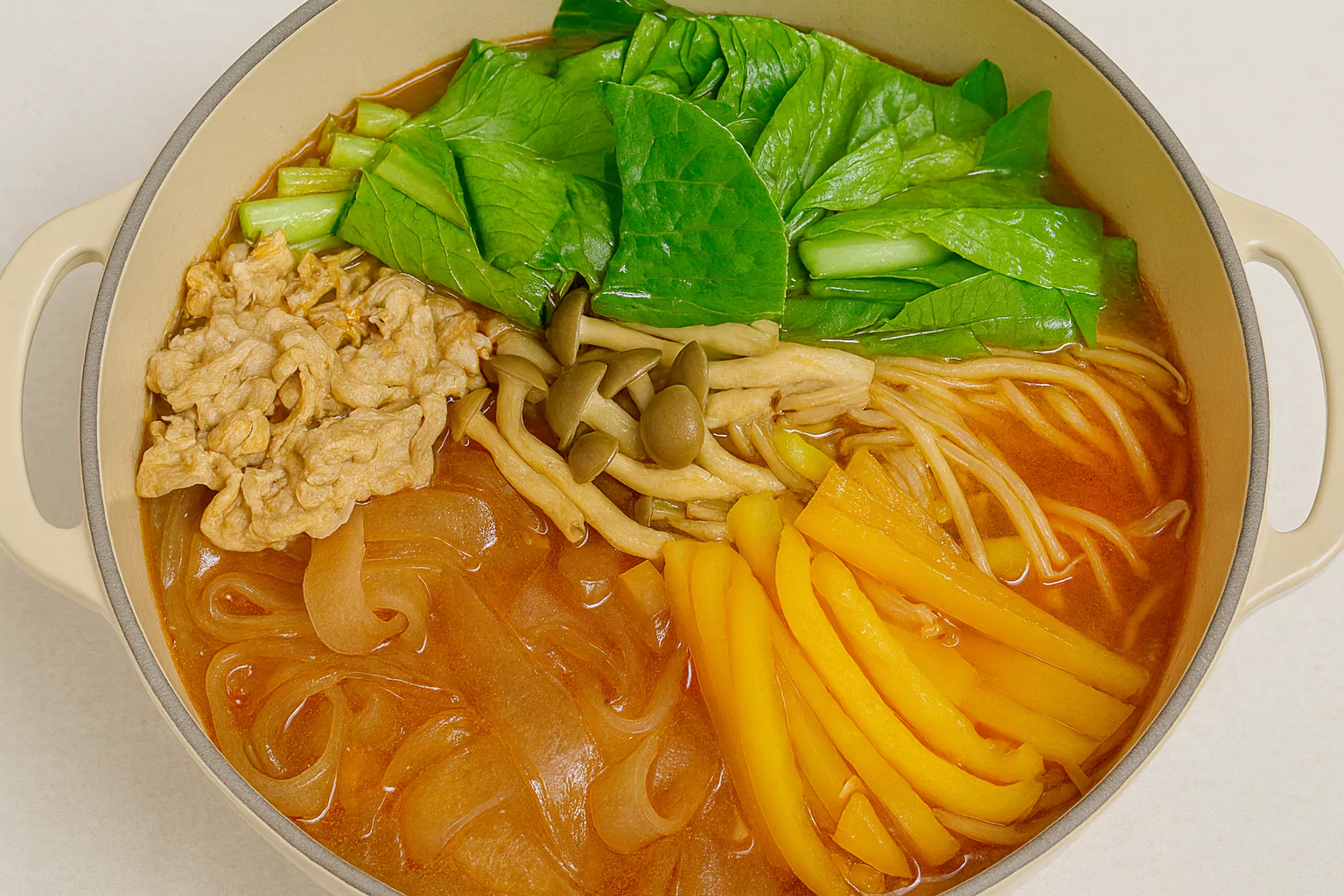
Secrets to Success and Expert Tips
- Add noodles at the right time. Glass noodles can become too soft if cooked too long. Add them near the end.
- Control the spice. If you’re new to spicy soups, start with less gochujang and add more later.
- Layer vegetables smartly. Stems go in earlier, leaves last, for the best texture.
- Custom protein. Chicken and shrimp are classic, but tofu and mushrooms make a vegetarian-friendly option.
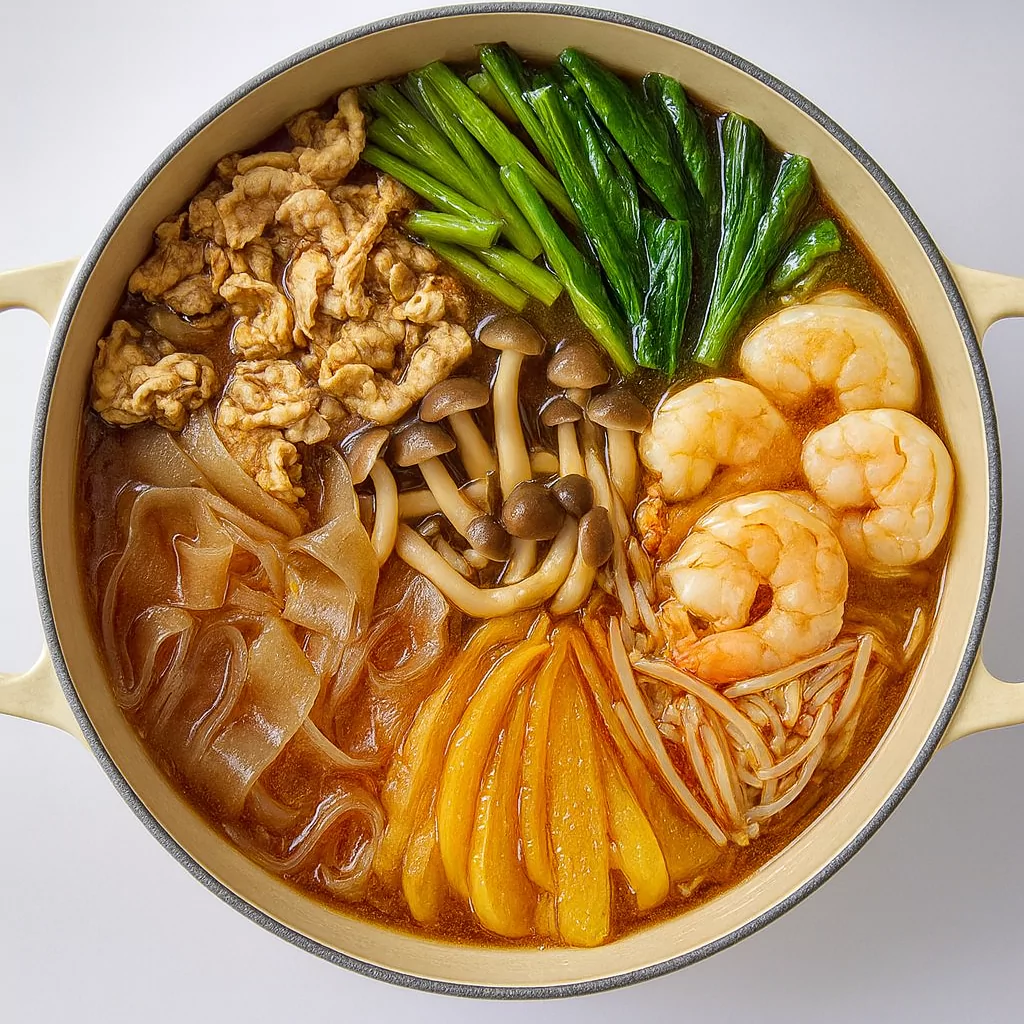
野菜たっぷり麻辣湯風春雨煮込み
Assembly and Presentation
To serve Stewed glass noodles:
- Place noodles in the bottom of the bowl.
- Ladle hot broth with vegetables and shrimp over them.
- Garnish with sesame seeds or scallions.
- Offer chili oil at the table for extra heat.
Hana’s Recipe Tips
- Use deep bowls to keep the broth hot longer.
- Cook noodles separately and add before serving if storing for later.
- Try serving Stewed glass noodles hot pot style, letting guests build their bowls.
Storage and Make-Ahead Tips
- Store: Refrigerate leftovers for up to 2 days.
- Reheat: Warm on the stove with a splash of water to loosen the broth.
- Make-ahead: Prepare broth and vegetables in advance, then add noodles just before serving.
Recipe Variations
- Seafood twist: Add clams, squid, or fish instead of chicken.
- Vegetarian option: Skip meat and use tofu and mushrooms.
- Mild broth: Replace chili paste with miso for a gentle flavor.
- Japanese style: Add a spoon of miso paste to deepen the broth.
For dessert lovers, this soup pairs wonderfully with Japanese sweets. You can try a light and creamy treat like Matcha Pudding after enjoying your Stewed glass noodles. The balance of spicy and sweet creates a perfect meal experience.
Conclusion
Stewed glass noodles with vegetables in spicy soup is the perfect combination of lightness and richness. It’s quick to cook, flexible with ingredients, and packed with nutrition. From chewy noodles to crisp vegetables, every spoonful feels warm and satisfying.
Once you try Stewed glass noodles, you’ll see why it’s a recipe worth repeating. Customize it with your favorite vegetables or proteins, and enjoy a bowl of spicy comfort whenever you crave it.
FAQs
Q1: Can I make Stewed glass noodles without spice?
Yes, reduce or skip the chili paste and oil. Use miso paste for a savory flavor.
Q2: Are Stewed glass noodles gluten-free?
Yes, most glass noodles are gluten-free. Always check the package to confirm.
Q3: What are the health benefits of Stewed glass noodles?
This dish is high in fiber, packed with vitamins, and provides lean protein. It’s light but filling.
Q4: Can I freeze Stewed glass noodles?
It’s better fresh. Freeze the broth alone and cook fresh noodles when reheating.
Q5: How spicy are Stewed glass noodles?
They are moderately spicy. Adjust chili oil and gochujang to taste.
After enjoying a comforting bowl of Stewed glass noodles, why not plan your next culinary or travel adventure? If you’re interested in exploring the beauty of Japan beyond food, check out the stunning Lavender Fields in Japan. It’s the perfect seasonal escape that pairs well with the joys of Japanese cuisine.
Stewed glass noodles with plenty of vegetables in spicy soup
Course: Main CoursesCuisine: JapaneseDifficulty: Easy4
servings15
minutes20
minutes~320 kcal
kcalIngredients
Beef slices (200g, thinly sliced into pieces) – Tender protein for richness (can substitute chicken thighs or tofu).
Shrimp (6–8 pieces, peeled and deveined) – Adds natural sweetness to balance the heat.
Bean sprouts (200g, 1 bag) – Crunchy and refreshing. Substitutes: bok choy or napa cabbage.
Komatsuna (½ bunch) – Mild Japanese leafy green. Substitutes: spinach, kale, or Swiss chard.
Yellow bell pepper (½ piece) – Sweetness and color.
Shimeji mushrooms (100g) – Earthy and soft. Substitutes: shiitake, enoki, or button mushrooms.
Glass noodles (80g dried) – The base of the dish, chewy and filling.
- For the broth:
800ml water
1 ½ tablespoons chicken stock base
1 ½ tablespoons gochujang (Korean chili paste)
1 ½ tablespoons soy sauce
½ teaspoon salt (adjust to taste)
- Aromatics & flavor:
1 teaspoon garlic, grated
1 teaspoon ginger, grated
2 teaspoons sesame oil
½–1 teaspoon white pepper powder
A drizzle of chili oil (for finishing)
Directions
- Step 1 – Prep the noodles and proteins
- ✔ Soak dried glass noodles in hot water or cook as per package instructions. Drain and rinse under cold water.
✔ Slice beef into bite-sized strips.
✔ Pat shrimp dry after thawing. - Step 2 – Prep the vegetables
- ✔ Cut komatsuna into 4 cm pieces, separating stems from leaves.
✔ Slice yellow bell pepper thinly.
✔ Break shimeji mushrooms into small clusters.
✔ Rinse and drain bean sprouts. - Step 3 – Build the flavor base
- ✔ Heat sesame oil in a large pot.
✔ Add garlic and ginger, sauté until fragrant.
✔ Add beef slices, stir-fry until no longer pink. - Step 4 – Add shrimp and mushrooms
- ✔ Stir in shrimp and shimeji mushrooms, cooking lightly for 1–2 minutes.
- Step 5 – Create the broth
- ✔ Pour in water, chicken stock base, gochujang, soy sauce, and salt. Bring to a gentle boil.
✔ Add noodles, bean sprouts, bell pepper, and komatsuna stems. Simmer for 2–3 minutes. - Step 6 – Finish the stew
- ✔ Add komatsuna leaves and simmer briefly until wilted.
✔ Adjust seasoning with white pepper and drizzle with chili oil before serving.
Notes
- ✪ Don’t overcook glass noodles—they soften quickly.
✪ For a vegetarian option, replace beef and shrimp with tofu and extra mushrooms.
✪ Adjust chili oil to match your spice preference.
✪ Serve hot in deep bowls and garnish with sesame seeds or green onions.

